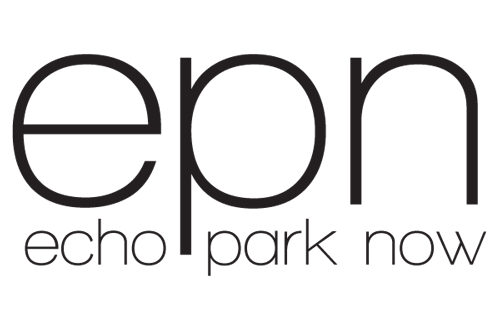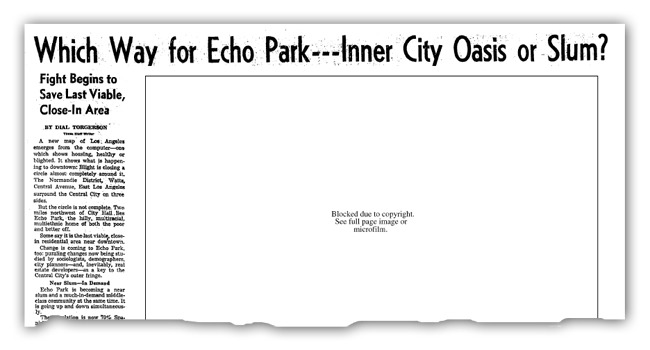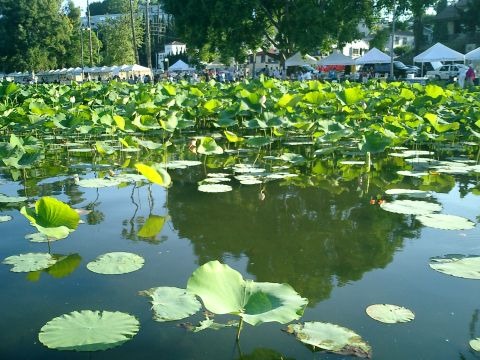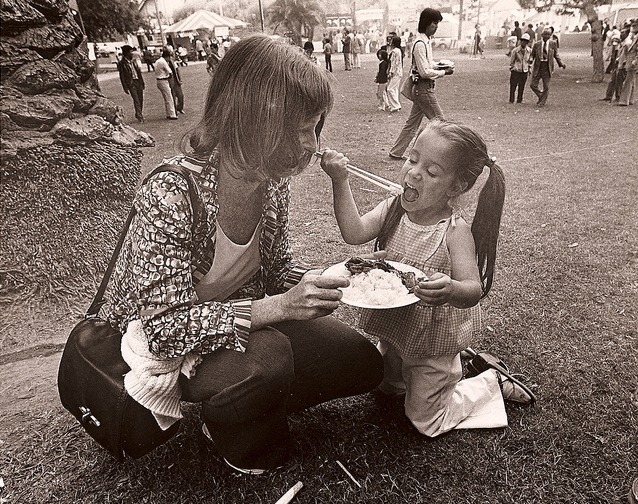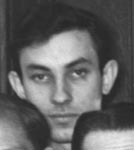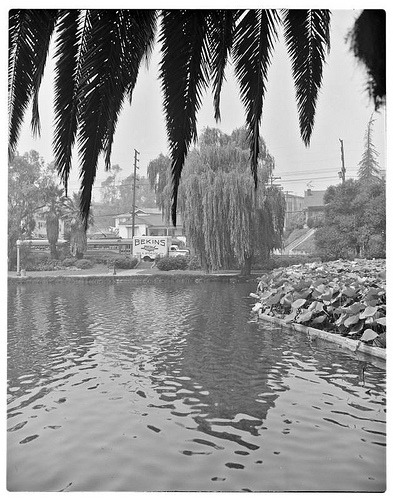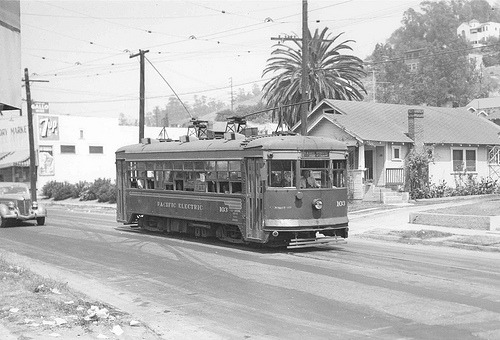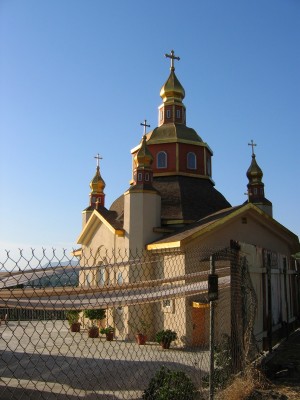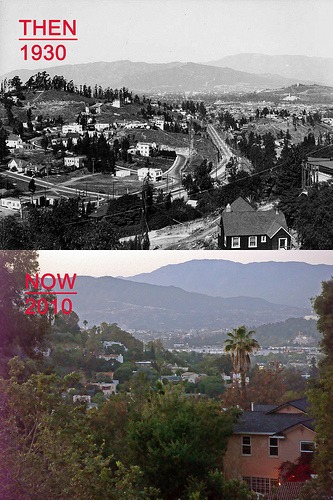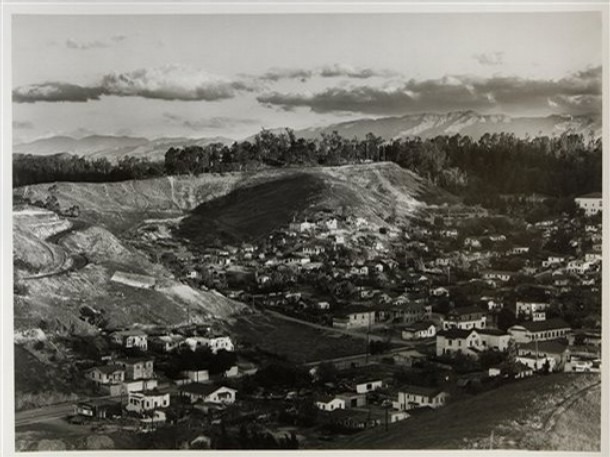This Echo Park property, listed on Trulia for $649,000, not only looks like a dream but also has an incredible backyard with a pool. Not that I could afford the two bedroom property anyways, the Baxter Street place does have an interesting history. The bottom photograph shows the 1917 Baxter Street house (built in 1910) being moved up the steep street in 1952. According to the listing information, it also was “featured on the Historical Society’s annual ‘Historic Home Tour’ and combines original architectural elements with a modern design sense.” With central heat and air, along with the gorgeous backyard, I’m ready to move in!
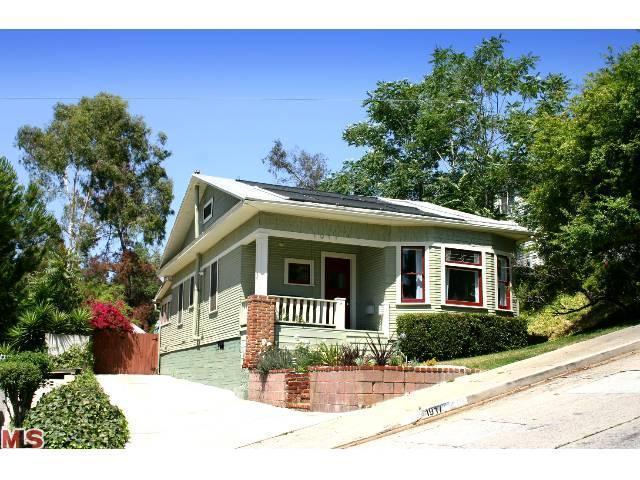
Tag Archive for: History
This 17-minute film by Kent MacKenzie shows the Bunker Hill area of Downtown LA in 1956. It’s an interesting film to watch for the footage of those original houses of those native downtowners before the city demolished the homes to make way for modern apartments and offices of a new downtown. The film follows some pensioners who, for obvious reasons, are not looking forward to the demolition of their neighborhood, once the “finest residential area in Los Angeles.”
There’s also some great footage of some really cool Victorian homes, as well as the original Angels flight and Grand Central Market.
h/t LA Observed for the video
Video Removed: Sorry guys, the awesome video was removed on August 3, 2010. The Vimeo Site sates “Vimeo has removed or disabled access to the following material as a result of a third-party notification by Milestone Film & Video claiming that this material is infringing: Bunker Hill 1956. We have no more information about it on our mainframe or elsewhere.”
I will repost the video if we find another online copy. Thanks!
Both Kelly and I (on separate occasions) dug up a rather interesting article from the L.A. Times circa 1971. The article, entitled “Which Way for Echo Park – Inner City Oasis or Slum?”, describes Echo Park at the dawn of the ’70s as:
…the hilly, multiracial, multiethnic home of both the poor and better off. Echo Park is becoming a near slum and a much-in-demand middle-class community at the same time. It is going up and down simultaneously. Newcomers from from poorer areas are crowding into substandard housing and youth gangs have become active. At the same time, there is a different influx: that of the middle class. Older couples who sold homes in distant suburbs and young marrieds with college degrees are seeking homes and rentals in the hills.
From what I’ve learned about Echo Park, it seems that it’s always been home to a mixture of different cultures and incomes. It’s interesting to see proof of this and to see an argument similar to the one happening today, taking place almost forty years ago. The same racial tensions that bubble beneath the surface of today’s arguments were there in the ’70s as well and, presumably, the ’60s. For example:
‘The rapidly changing ethnic composition of the Silver Lake-Echo Park communities will soon transform Echo Park into a Mexican-American barrio,’ said a UCLA study for the city’s new general plan. ‘We strongly urge that, via the process of community organizations and related efforts, steps be taken to avoid further ghettoization.’ Many long-time residents of Echo Park, members of its Latin community, object to experts’ blaming Latins as the bringers of the slum.
Eek! Yeah, I think an objection to that study is justified. The article also brings up some interesting bits about the cultural differences between certain residents of Echo Park. Some of these descriptions sound vaguely familiar…
The Hip community calls it “The Other End,” the other end of Sunset Blvd. from the Strip. Barefoot hippies buy food with food stamps in the same supermarket lines with young deputy public defenders with mod clothes and lavish mustaches. Chicano street types dress in a uniform of neat jeans (or overalls) and clean white T-shirts; they haven’t learned, as have their Anglo contemporaries in the suburbs, to believe that dirt is somehow revolutionary.
Read the full article here (PDF download).
Since we didn’t publish our usual “Flashback Friday” history post yesterday, with the Lotus Festival going on I thought it’d be a good opportunity to do a quick history of the Fest.
The Lotus Festival started out being called “The Day of the Lotus,” and debuted at Echo Park Lake in 1972 thanks to the Department of Recreation and Parks and members of the Council of Oriental Organizations (COO). Each festival takes place in July, timed for the blooming of the lotus flowers. Starting out as one-day affairs, the Day of the Lotus was designed to promote awareness of the contributions by Asian Americans to our culture and communities. The festival focuses on a different Asian ethnicity each year, this year they will showcase the Chinese culture.
This week’s Flashback Friday comes to us courtesy of L.A. Creek Freak, an incredibly informative and unique blog that addresses both the ancient and the modern history of Los Angeles’ rios and arroyos, many of which are currently “degraded and forgotten.” The writers speak out and seek to educate readers on L.A.’s ecology, believing that “our rivers and creeks are vital to our communities and our planet.”
A few months ago, Jessica Hall of the Creek Freak website posted a fantastically creepy story about a murder that occurred in Elysian Heights over one hundred years ago. The story came from an old L.A. Times article, found by reader David Kimbrough. Here’s the story, as summarized by Jessica:
On the evening of December 27, 1904, Columbus C. Champion, 67, committed fratricide, shooting down his brother Thomas in a “deadly fusillade…in front of the Elysian Springs bottling plant,” for whom Thomas worked as a water delivery man. Columbus, called “Lum,” lived on property next to the bottling company.
Lum had already been abandoned by his wife, son and father several months previously, and neighbors believed it was “worth almost any effort to keep on good terms. It is said he has terrorized the neighborhood on numerous occasions…” Earlier in the day, he fired BB shot at his niece, threatening to kill the entire family, which precipitated the deadly confrontation with his brother.
Thomas, returning to the Elysian Springs Bottling Company, rode his wagon with his son Sam past Lum’s property:
“At once the old man rushed out of the house and began to abuse his brother. Sam Champion, fearing for his father’s safety, secured a revolver from the home, and started up to where his father and uncle were quarreling. The younger brother (Thomas) was trying to ward off the attacks of Lum, and just as Sam arrived his father told Lum to go back into his own lot and leave him alone, or he would knock him down. With an oath, Lum started toward the cottage, crying out that he would kill the whole outfit. He quickly reappeared with his gun, and when within twenty feet of this brother fired the load of shot into his breast. Thomas sank to the ground and expired almost immediately.”
The villain was unrepentant and actually joking with the police who carried him away.
Creepy! So if you’re ever wondering about possible hauntings in Elsyian Heights, this might be a good place to start.
Also, how cool is it that there was a bottling plant in Elysian Heights?
This Thursday, June 24 at 7:00 pm, SurveyLA and the Los Angeles City Historical Society are teaming up to raise awareness of their mission and to give a talk on the history of Barlow Respiratory Hospital.
Funded by a grant from the J. Paul Getty Trust, SurveyLA’s goal is to more thoroughly identify and document Los Angeles’ historic landmarks. At the end of its six-year survey (the second year of research includes Echo Park), the organization will present its findings to the city, homeowners, preservation groups and neighborhood groups so that both developers and property owners are not “surprised or exasperated by eleventh-hour preservation efforts.”
On Thursday, Flora Chou from the Los Angeles Conservancy will be giving a brief talk on the history of Barlow before Janet Hansen discusses the SurveyLA project (“what it is, where it’s happening and how all of us can contribute“).
The talk will be at Williams Hall at Barlow Respiratory Hospital (2000 Stadium Way) at 7:00 pm. Parking is free. Light refreshments will be served.
Click here to download the flyer.
Big news! A suspected communist was arrested at his apartment at 1420 Echo Park Ave. and charged with “teaching and advocating overthrow of the U.S. government by violence”… on September 17, 1952.
Echo Park was home to a lot of communists and socialists during the couple of decades after the first Red Scare (in the 1920’s) and before the second Red Scare (in the 1950’s). However, it’s difficult to find information on the group’s activities as it is (understandably) not widely published. Most of the information we have are personal accounts and newspaper articles. That’s where the handy-dandy Los Angeles Times archive at the L.A. Public Library comes in!
I found an interesting little nugget of an article about a man named Robert Manewitz who was picked up by the FBI at his apartment in Echo Park. A long-time Communist Party member and the son of Russian immigrants, Manewitz first started organizing laborers and protests in the Midwest in the 1930’s. According to the article, he came to Los Angeles from Missouri in order to “take over the duties of some of California Communist Party leaders who had been arrested on similar charges of Smith Act violations.”
The Smith Act is a statute that basically says it’s illegal to do or say anything that could be seen as an attempt to overthrow the U.S. government. And you wanna know the really fun part? Although most of the cases under it were thrown out as unconstitutional, it’s still on the books today.
And what did Manewitz say to the press? “He refused to comment on the charges against him, saying only: ‘I don’t know what it is all about.'” Good man.
We’ve been so fascinated with the Red Car line history as of late, and thought we’d share a couple of old photographs of the Red Cars that passed through Echo Park on the way to Glendale and back. The last Red Car passenger was in 1955.
It’s Memorial weekend, you might want to take a nice walk/hike along the old Red Car property near Corralitas Drive. Click here for directions and more information.
It’s probably caught your eye at some point while strolling around the neighborhood: a golden rooftop situated near the top of that one hill, elusive, not visible from just anywhere. Well, I hate to spoil the mystery for you, but it’s the St. Andrew Ukrainian Orthodox Church, and it’s located at 1456 Sutherland Street. Sutherland is one of the steeper streets in Echo Park, but I recommend walking up it in order to see this fine piece of religious architecture. Or you can just sneak a peak at it from that grassy area at the top of Douglas and Quintero (see photo above).
Echo Park seems like an odd place for a Ukrainian Orthodox church to be located until you realize that Echo Park has always been a haven for outsiders, free-thinkers, artists, bohemians and even refugees from other countries. Below is some of the text from a Los Angeles Times* article that I found from December 16, 1957 commemorating the dedication of the church.
On an Echo Park district hill in a converted mansion yesterday people jammed tightly into a 20 x 20 foot room and stood for two hours. The ceremonies were performed in the little St. Andrew’s Church of the Ukrainian Orthodox Church at 1456 Sutherland St. Its membership includes only 85 families.
This one had escaped from Siberia through China. That one and his wife had fled to the West. The next one had seen his parents shot. This teen-ager had been baptized in the Ukraine at the risk of his parents’ lives. Still another was the last member of a large family – the only one to live through both Communist and Nazi persecution. The church was started principally with refugee members seven years ago in a rented hall. Four years ago the congregation bought the outdated mansion for $20,000, and since then has rebuilt it into a church.
The church’s website also contains lots of information on Ukrainian culture and history. I recommend checking it out if you’re interested in world history. I had never heard of the Holodomor before.
*All Los Angeles Times newspapers from 1881 to 1986 have been scanned and are searchable, viewable and printable from any computer at the LA Public Library!
The caption for this photo reads:
In the early part the of the previous century, the Los Angeles Red Car Line was extended to Glendale. The “Glendale Line” made a path from downtown Los Angeles to Glendale through “Edendale,” now known as Silver Lake, Echo Park, and Elysian Heights. To create the line they had to blast through the hills, creating what was then known as the Edendale Cut. The Edendale Cut was the portion located between the Key Stone Station at Max Sennett’s studio to the India Street Station. All that remains of the Glendale/Edendale Line is the unused right of way.
Today is May Day, and 1910 in Echo Park saw 3,000 gatherers at the Echo Park Playground where they crowned Miss Ethel Pruett Queen of May.
“Three thousand men, women and children were present. As many came back for the evening’s part of the program. It was one of the most notable affairs that has ever been recorded in the history of Los Angeles, where children have taken apart.”
The Playground mentioned in this L.A. Herald article refers to a park that used to stretch from Bellevue Avenue south to Temple street, now bisected by the 101 Freeway.
From the Echo Park Historical Society website: “Huge May Day celebrations occupied the outdoor playground, and by 1912 the playground had thousands patrons in a single year, some of whom arrived from downtown on the Pacific Electric streetcar that moved up Glendale Boulevard (then known as Lake Shore).”
Thanks to LAHistory Twitter page for the link to this fun, historic newspaper article!

Don't you just wanna sit on his lap and have him tell you stories about being a vaudeville performer?
In the first couple decades of the 20th century, Echo Park was the center of the West Coast film industry. Called Edendale at the time, it was the location of several major silent film studios including Keystone Studios, Pathe West Coast and Selig-Polyscope. Even Fox Studios was located here before William Fox changed its location to Sunset and Western in 1917. The studios were located along what is now Glendale Blvd. (called Allesandro Street at the time) near the 2 freeway terminus.
Selig-Polyscope was the first motion picture studio in Edendale and, in fact, the first motion picture studio to be located on the west coast. Its founder, William Selig, moved it here from its original location in Chicago in 1909. Selig’s story is a fascinating one as he was truly a visionary and a pioneer in the early days of film making. He developed his own way of making a motion picture camera in order to not have to pay a patent fee to Thomas Edison’s company. He was the first motion picture producer to move his studio to Los Angeles. He made almost a thousand films in his studio in Edendale before moving its location to Lincoln Heights (East Los Angeles) in 1917. He also opened up a zoo in Lincoln Park in 1915 and had plans to turn it into a big ol’ amusement park with rides and everything.
However, Selig-Polyscope was unable to survive the transition to full-length films and closed in 1918. As for the zoo, “only a single carousel was ever built and the crowds never came” (Thanks to Wikipedia for the hear-wrenching imagery), and it finally shut down in the 1930s. Selig lost almost everything else he had in the Great Depression and spent the last few years of his life working as a literary agent. He died in 1948, but his memory lives on through Los Angeles history nerds (like me). Think of him every time you see that big empty lot on Glendale and Clifford.
During the 1940’s, Chavez Ravine came to the city’s attention as an area ripe for re-development. At the time, it was the home of a well-established, predominantly Mexican-American community. It was poor but pastoral and self-sufficient. Many of its inhabitants grew their own food and raised their own animals. This small, hidden valley was home to several hundred families many of whom had trouble finding other places to live due to housing discrimination.
During the post-World War II housing shortage, the city of L.A. looked to Chavez Ravine as the perfect place to build public housing (rooms that were meant to be rented-out by low-income families). In preparation for the building of this complex (to be known as “Elysian Park Heights”), most of the inhabitants of Chavez Ravine were evicted from their homes. But before construction even began, the political climate in L.A. changed drastically. It was the height of the Red Scare and this plan for public housing were a bit too socialist for L.A.’s public officials including the newly-elected mayor. The planner of this project, Frank Wilkinson, was then called before the House Un-American Activities Committee. His was fired due to his refusal to confirm or deny Communist Party membership.
The project died, and in the meantime, Chavez Ravine was still occupied by a small number of its original inhabitants that refused to leave. In 1958, the city of Los Angeles (wanting to pull in the revenue that would come from having a major baseball franchise) sold the 352 acres of land to the Brooklyn Dodgers. The remaining residents were forced out through the use of condemnation or eminent domain. A handful of residents avoided this and held out until the very end when, in May of 1959, the sheriffs department came in with bulldozers and armed men and physically forced them out.
The story of Chavez Ravine is a complex and interesting one, and I highly recommend that those who are interested in it read more about it. One of the best books on the subject is Don Normark’s Chavez Ravine: A Los Angeles Story. As a young photographer in 1949 he photographed the residents of Chavez Ravine. Years later he found many of the people that he photographed and their memories make up the majority of the book’s text.
Ever heard of Chavez Ravine? A lot of people haven’t (even those who live right next to it) as it doesn’t really exist anymore. It was the neighborhood that the city of L.A. bulldozed in order to build Dodger’s Stadium. But that’s a whole other ball of wax, and a piece of history that will definitely be addressed in my next post. But I figured (what with baseball season beginning this week) it would be timely to write a Chavez Ravine-related post.
Julian Chavez was the man after which Chavez Ravine was named and the original “owner” of the land on which Dodger’s Stadium now sits. Chavez came to California from New Mexico in the 1830s. At the time, California was part of Mexico and was transitioning from being dominated by Spanish-owned missions to being divided into ranchos. During this period, one had only to petition the ayuntamiento (city council) and ask for a piece of land. In this way, Chavez acquired the 83 acres of land near downtown in 1844 that became known as Chavez Canyon.
His land was used by the county as the site of a pest farm/isolation hospital (I can only imagine that this would be a place that they sent people to die) during the 1850s and 1880s when there were local smallpox outbreaks. It was primarily used to house Chinese and Mexicans who suffered from the disease. A smallpox hospice was on the site of Dodger’s Stadium. Isn’t this interesting?!?!
In 1846, California passed from Mexican to American hands. Six years later, in 1852, Chavez was elected to the first L.A. County Board of Supervisors. He continued to serve the city in various roles until his death in 1879.
Stay tuned for next week’s installment of Flashback Fridays: Chavez Ravine!
These videos were recently posted on YouTube by the Natural History Museum of Los Angeles, but we found them via LA Eastside. There are five videos and they each discuss the history and the individuals behind Los Angeles’ street names. Most of the videos discuss the streets that made up the the city of Los Angeles in her earliest incarnation. These include the streets surrounding El Pueblo de Los Angeles, Chinatown and Downtown. Videos number four and six talk a bit about the history of some Echo Park street names. Check ’em out!
Go here if you want to view NHMLA’s other videos.
